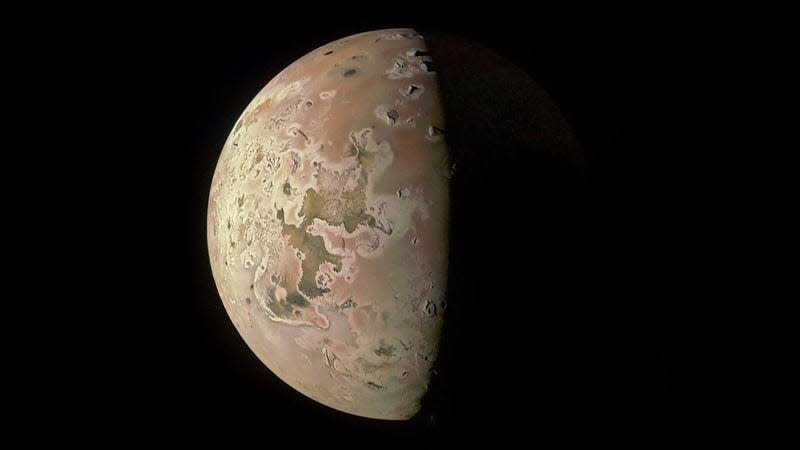Juno Spacecraft Gears Up for Closest Look at Jupiter's Tormented Moon

The north polar region of the Jovian moon Io shown in this image taken on October 15 by NASA’s Juno.
NASA’s curious Jupiter probe is getting chummier with the planet’s most erratic moon, Io. The Juno spacecraft will carry out the closest encounter any mission has had with the volcanic moon in over 20 years, collecting valuable clues about its mysterious activity.
Juno will make its flyby of Io on Saturday, December 30, coming within 930 miles (1,500 kilometers) from the hellish surface of the Jovian moon, according to NASA. The spacecraft has observed Io during previous flybys in May and July from distances ranging between 6,830 miles (11,000 kilometers) to over 62,100 miles (100,000 kilometers). This upcoming flyby is a rare opportunity to get up close and personal with Io, the most volcanically active body in the solar system.
Read more
Atlanta Area Family Finds Out The Hard Way That New Cars Can Melt In The Sun
Max Verstappen Too Young To Rent AMG GT Sports Car On Vacation, Settles For BMW 5 Series
During its upcoming flyby of Io, the spacecraft will focus all of its three cameras on the small moon. The Jovian Infrared Auroral Mapper (JIRAM), which takes images in infrared, will collect heat signatures emitted by volcanoes on the moon’s surface, while the spacecraft’s Stellar Reference Unit (a navigational star camera) will capture the highest-resolution image of Io’s surface ever taken. The JunoCam imager will take visible-light color images of the moon.
Juno is scheduled for a second close flyby of Io on February 3, 2024, in which the spacecraft will come within about 930 miles (1,500 kilometers) of the moon’s surface. During those upcoming flybys, scientists will have the opportunity to gather data provided by Juno combined with remote observations by the Hubble and Webb space telescopes.
“With our pair of close flybys in December and February, Juno will investigate the source of Io’s massive volcanic activity, whether a magma ocean exists underneath its crust, and the importance of tidal forces from Jupiter, which are relentlessly squeezing this tortured moon,” Bolton said.
For more spaceflight in your life, follow us on X (formerly Twitter) and bookmark Gizmodo’s dedicated Spaceflight page.
More from Gizmodo
Consumer Reports Says These Are The Least Reliable Cars For 2024
Former Bachelor host Chris Harrison addresses "toxic" relationship with television show
‘The Color Purple’ Stars Explain Film's Lesbian Love Affair Between Two Characters
Pour One Out For These Nameplates Because They’re All Getting The Axe In 2024
Sign up for Gizmodo's Newsletter. For the latest news, Facebook, Twitter and Instagram.

